Frank Lampard had it all to figure out, although being a goal up after five minutes, the former Chelsea skipper turned manager looked in command to collect his first trophy in his debut season as Blues boss. Only then to lose his captain César Azpilicueta and talisman Christian Pulišić to hamstring injuries inside the opening hour, along with his midfield maestro Mateo Kovačić seeing red at 73 minutes. The young English manager was unable to engineer his side’s equaliser from the bench with ten men for the remaining 25 minutes they trailed in the game.
Arsenal held on to their 2-1 lead for the closing 25 plus minutes to claim the oldest prize in world football, winning the FA Cup for a club and national record 14th time. Post-match, the happy and humble Gunners boss Mikel Arteta was quick to pay tribute to the character of his side’s performance. There was also a special tip of the hat to Manchester City manager Pep Guardiola for his tutelage and shared experience that helped shape the young Spanish manager.
The tactical analysis looks at the essential tactics and talking points that characterised this all-London final. The analysis will offer a comprehensive look into how both these sides set up to get success while neutralising their opponent’s threat.
Lineups
Both sides set up in a 3-4-3, and with similar tactics in and out of possession, where individual matchups were critical in determining which side would control the game. Both sides opted for a back-three to give them numerical superiority building through the thirds.
Arsenal kept their shape for the full 90 minutes while later in the second half Chelsea switched to a 4-4-1 to compensate for being a man down while remaining competitive.
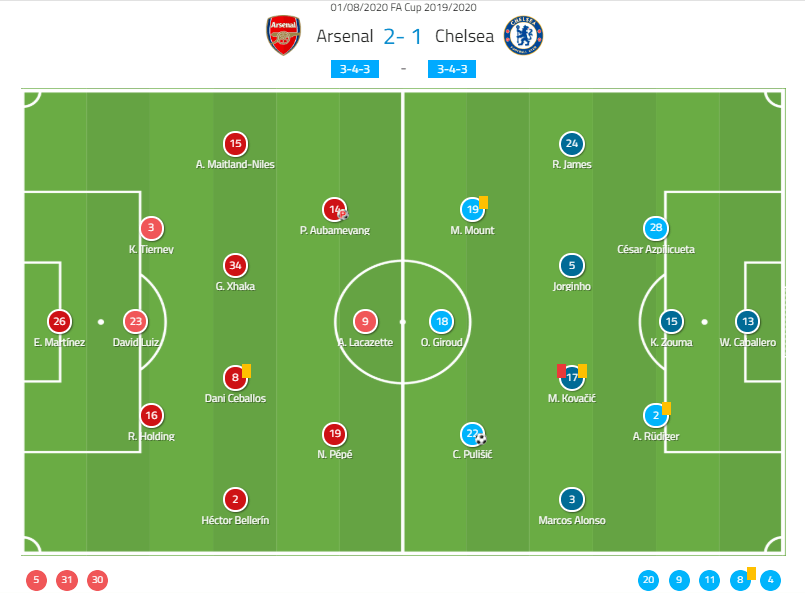
Arsenal: 3-4-3
The tried and trusted Emiliano Martínez started as the last line of defence for the Gunners, just in front Rob Holding, David Luiz, and young Scottish international Keiran Tierney made up the back-three.
Héctor Bellerín and Ainsley Maitland-Niles operated both right and left flanks respectively as wing-backs. At the same time, Dani Ceballos and Granit Zhaka controlled the tempo of Arsenal’s play from the middle.
The front three of Arsenal could all be considered as proficient creators and finishers, Pierre-Emerick Aubameyang and Nicholas Pepe played as inverted forwards, cutting in with an angle for goal on their dominant foot, while Alexandre Lacazette played as the target man who would meet crosses and hold up the ball.
Chelsea: 3-4-3
Wilfredo Caballero made his third start in goal for Chelsea, while just in front César Azpilicueta, Kurt Zouma, and Antonio Rüdiger made up the back-three.
20-year-old English prospect Reece James and Marco Alonso commanded the flanks as Jorginho and Mateo Kovačić controlled the Chelsea attack from the centre of the park.
Former Gunner Olivier Giroud was the focal point of the front three, meeting ariels balls and crosses into the box. While operating from both half-spaces either side was young American Christian Pulišić on the left and academy graduate Mason Mount on the right.
Dynamic duo control the early stages for Chelsea
By the time referee Anthony Taylor blew the whistle for the first water break on 22 minutes, Chelsea seemed on course for a comfortable win. After five minutes Pulišić became the first American to score in an FA Cup final giving Chelsea a 1-0 lead after some poor defending by Arsenal. Chelsea commanded 65% possession of the ball up to that point, and they seemed to have Arsenal neutralised on all fronts.
Chelsea was efficient at playing out from the back against a high-press, as well as building through the middle third to release key passes to the runs of the forwards. Crucial to this success was central-midfielders Jorginho and Kovačić. Both players were exceptional at receiving and turning under pressure as well as skipping challenges from their opposite numbers, to dribble forward and engage the backline of the men in red.
Making well-timed runs to receive passes and using good horizontal rotations to receive and play out of pressure, the midfield pair were the catalysts in creating Chelsea’s early dominance.
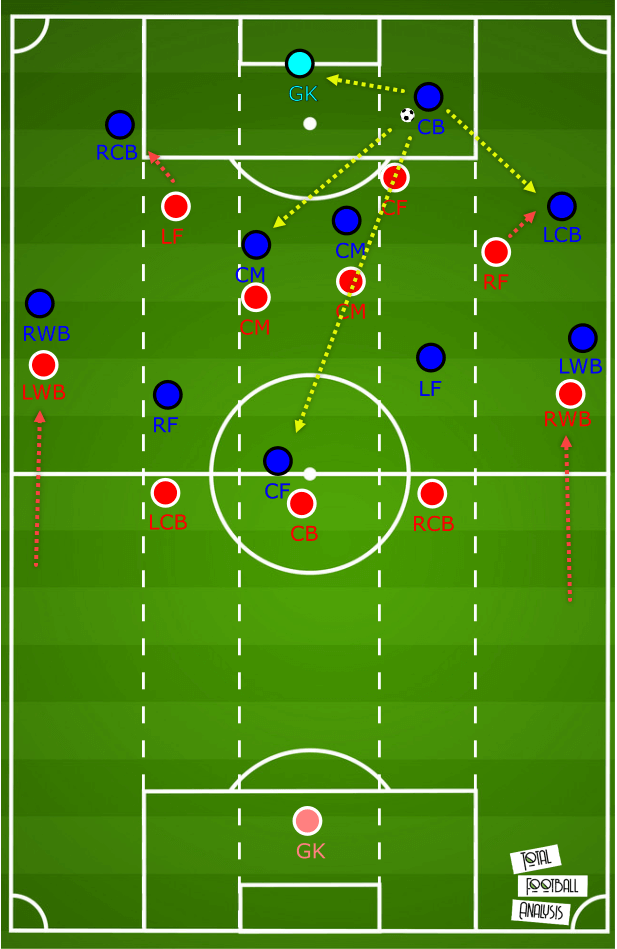
Above, is an illustration to show the tactics of Chelsea’s options from the build-up. Like Chelsea, Arsenal pressed high and looked to cut down the Blues attack from its inception. As both teams played the same formation ‘3-4-3’, this meant Arsenal could man-mark Chelsea in the build-up, including all three centre-backs. In order to play out of pressure, Chelsea’s technically proficient midfielders needed to be able to receive the ball in front of their own box to turn and play forward.
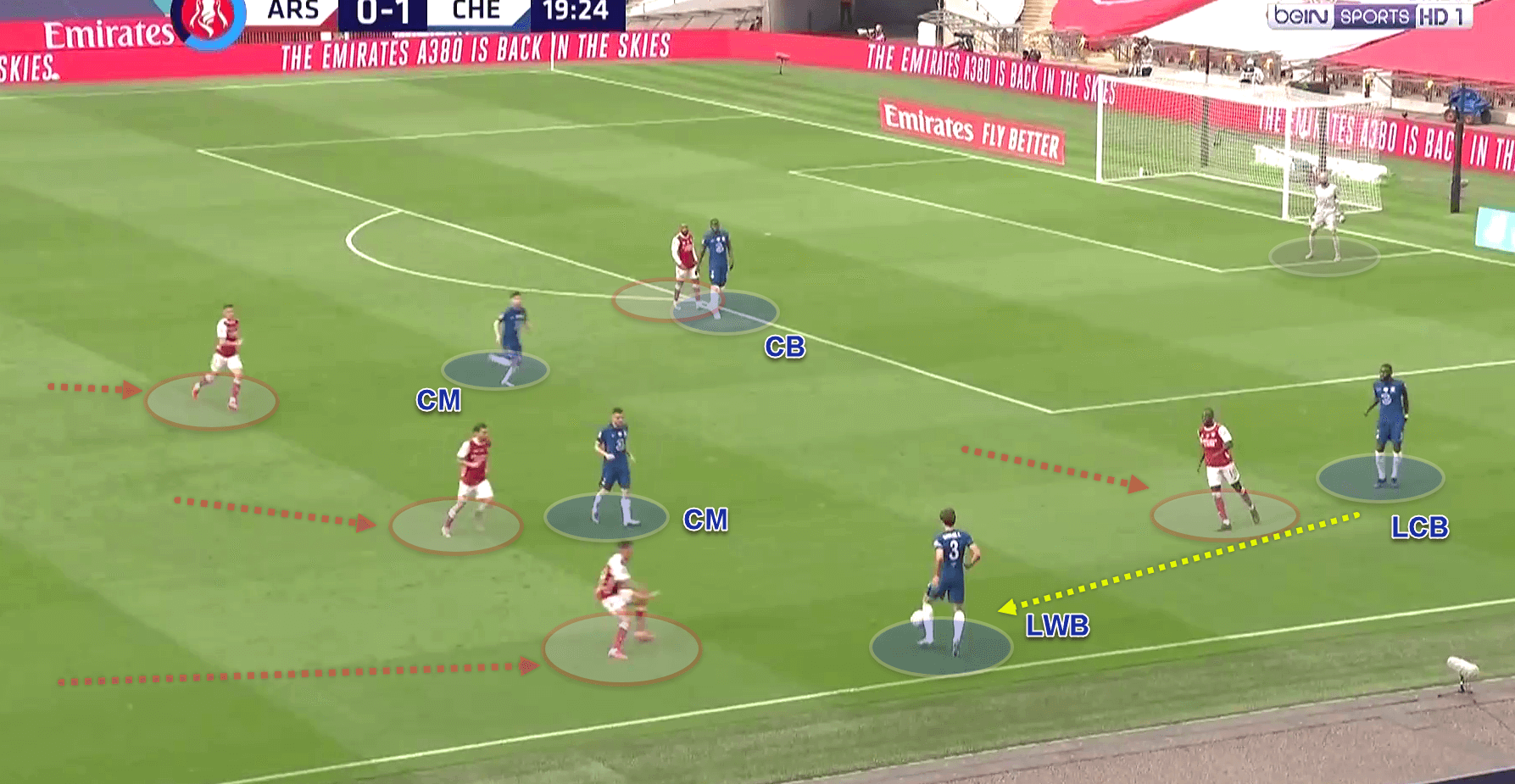
Above we see a moment when Chelsea was pressured in the build-up phase. Left-wing-back Alonso is under pressure on his first touch, notice the only viable passing option is the oncoming central-midfielder Jorginho, approaching from behind teammate Kovačić.
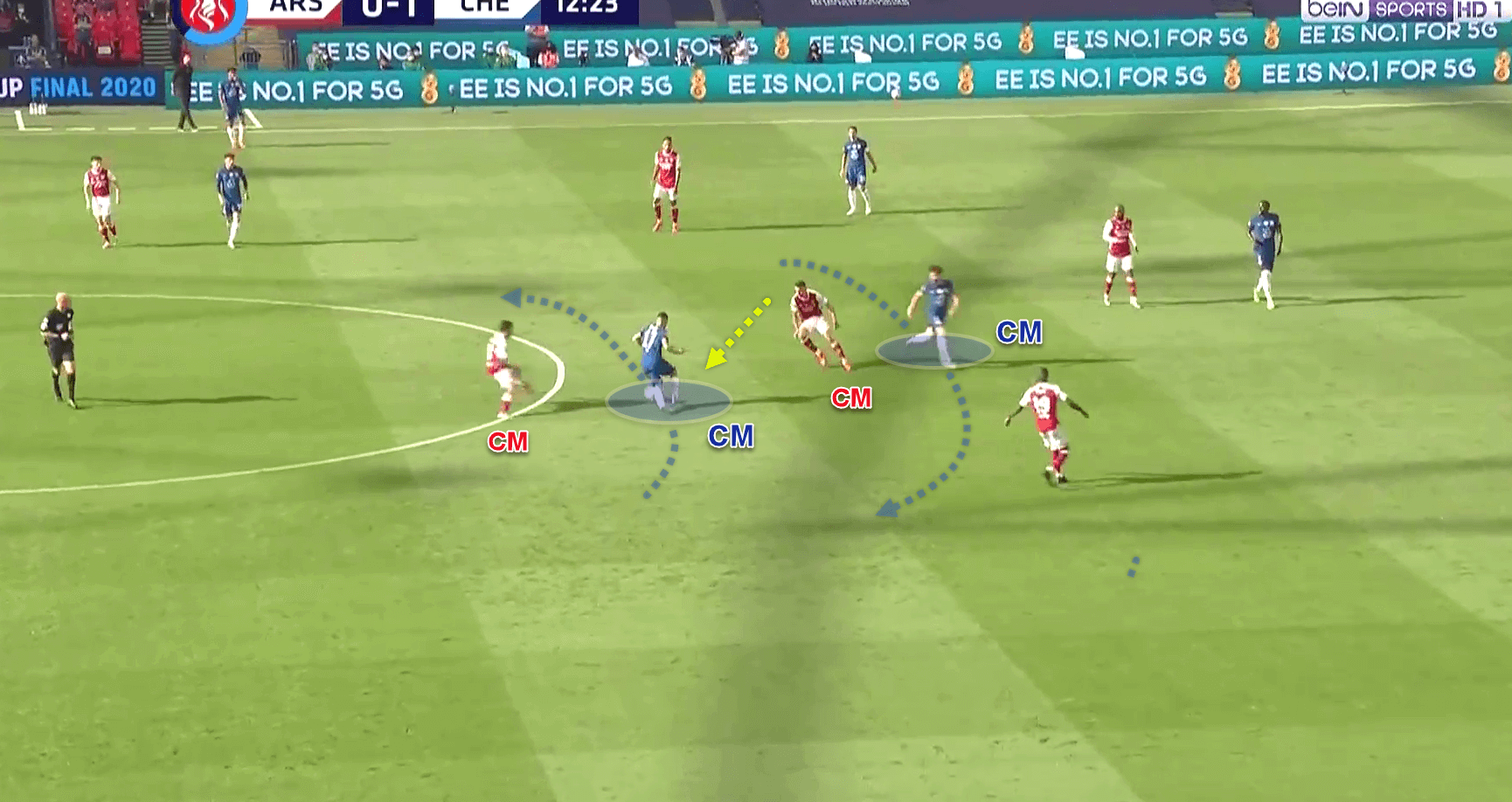
In the image above, we see Jorginho and Kovačić make a high to low horizontal rotation to escape from the 2-v-2 pressure inside their own half. Jorginho plays a pass to Kovačić and continues his run deep around the position of his teammate, while Kovačić takes his first touch back into the space the pass came from as he attacks the space vacated by Arsenal midfielder Granit Xhaka.
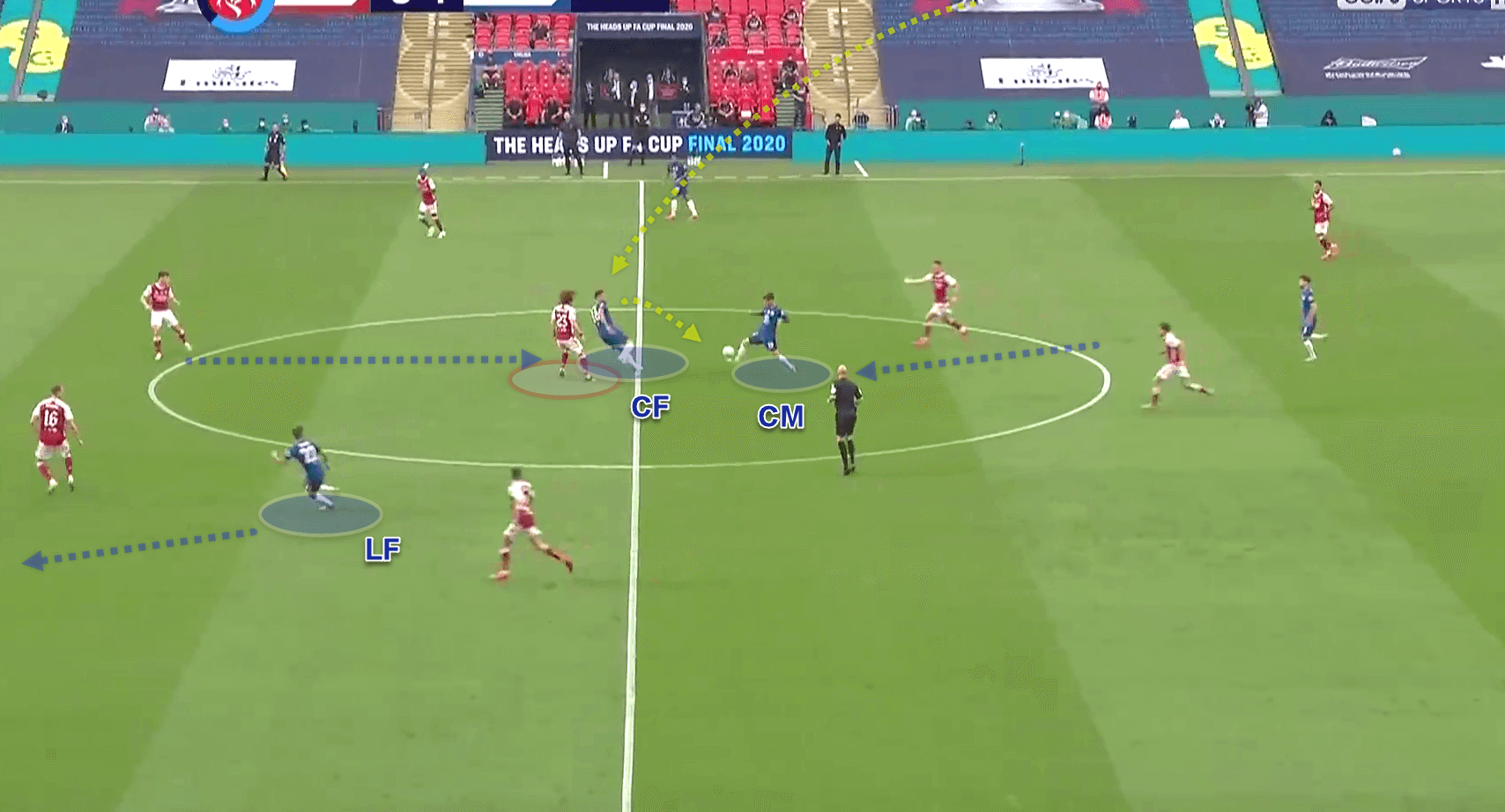
When all short passing options had been neutralised Chelsea would opt for a long pass out of pressure to the centre-forward to collect and lay off short passes to oncoming midfielders, Kovačić and Jorginho. In the image above we can see the physically capable forward, Olivier Giroud come from high to receive a long ball from Caballero. Giroud protects and offers a knockdown header to meet the run of the oncoming Kovačić.
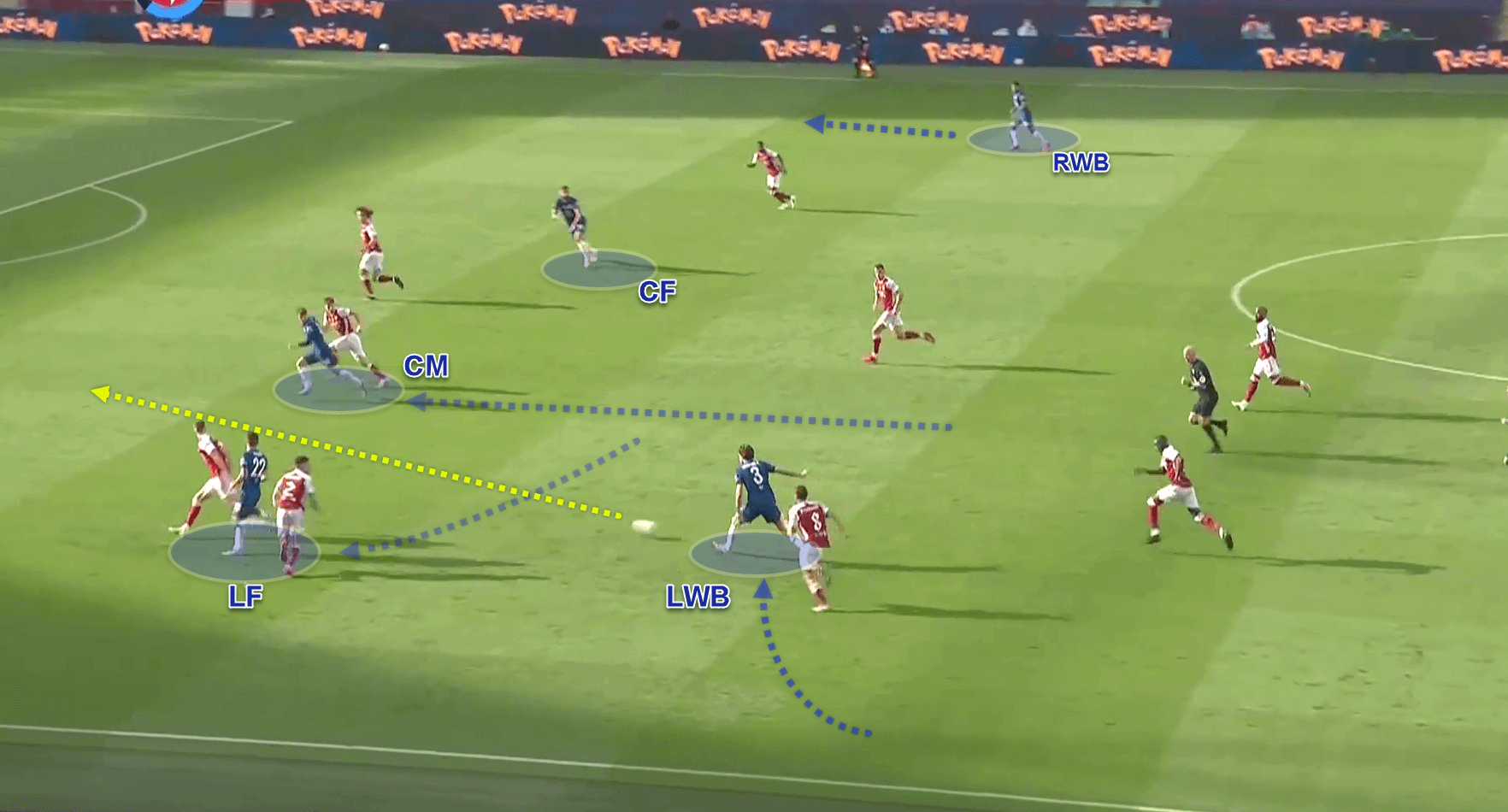
In the final third, Kovačić and Jorginho would make forward runs to meet penetrating passes from deep. These runs were generally central and not any wider than the half-space. In the image above, we see Kovačić makes an attacking run to meet the through ball from Alonso. Notice the space to run and play a pass is created from the wide run of left-forward Pulišić.
Post-match, Blues boss Lampard was critical of the fact that his own side did not continue to play as well as they did in the first half. Not playing forward between the lines and exploiting the Gunners’ weak side with their lack of purpose at these times was perhaps what caused them more problems.
Arsenal’s inverted forwards quick on the break
If Arsenal writes a book on this season’s FA Cup campaign, one chapter will surely have to be named, ‘Counter attacks and Aubameyang’. When the Gunners seem to lose all sight of passing options playing out of pressure, what almost seems like a panic clearance manifests into a superb ball to meet the blistering run of the Arsenal frontman Aubameyang.
Just like he did against Man City, Aubameyang broke down the left with a long pass to drive into the box, only on this occasion, the Arsenal forward won a penalty. The leading goal scorer for the club this season converted from the spot on 27 minutes to draw the sides level 1-1.
Arsenal struggled to play through the high-press of Chelsea, as the Blues also went man for man in the Arsenal build-up, as the intensity of the press forced Arsenal players back into their box and even their own corner flag. As a result of this pressure, when shorter forward passing options were declined the Gunners opted for distance, where one of the wide forwards would meet a long direct pass into the vacated channel to exploit a stretched and disorganised Chelsea defence.
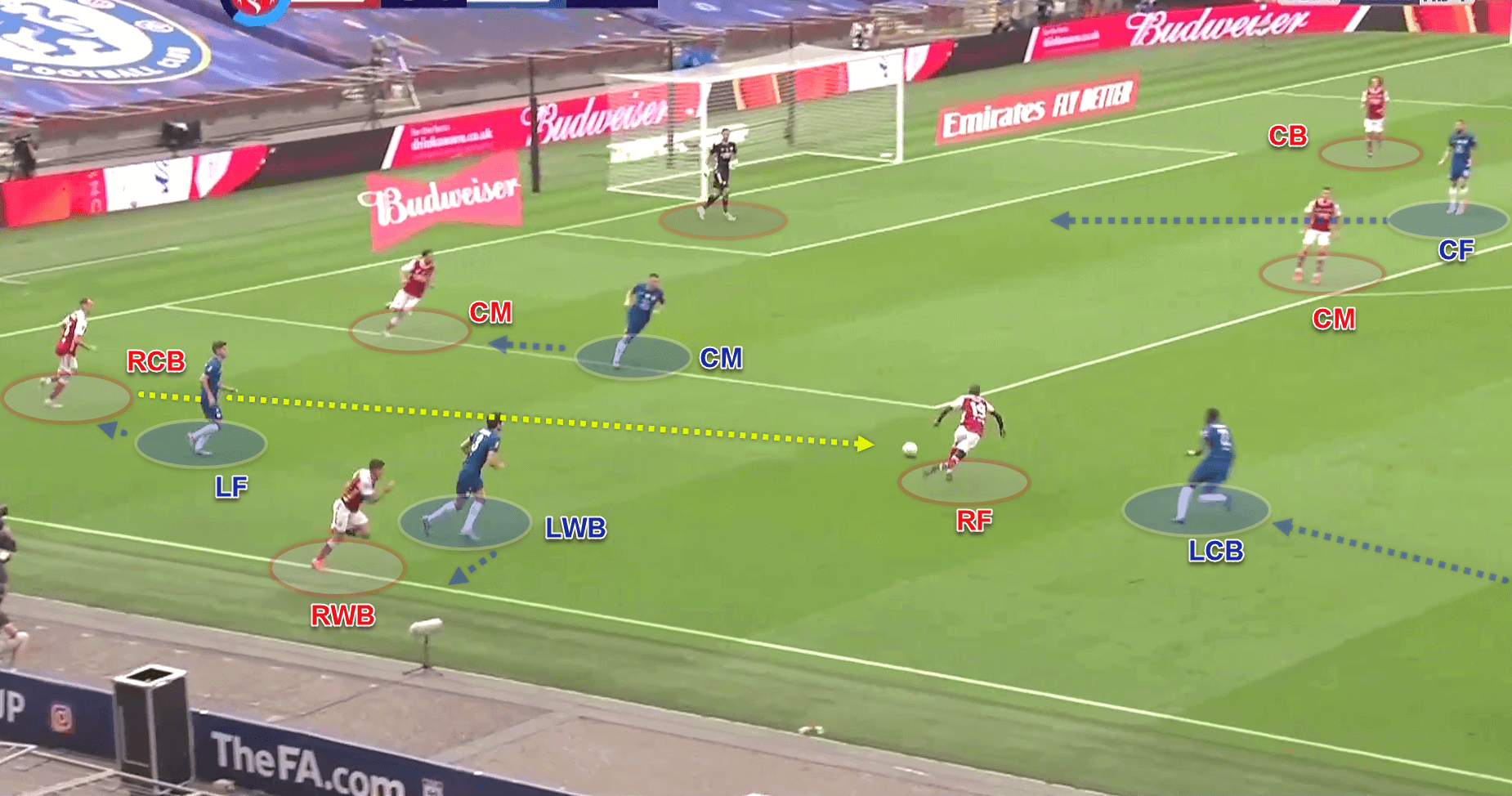
Above, we see how intensely, and high Chelsea pressured Arsenal in the build-up. Notice how high the Blues left-centre-back Rüdiger came to deny his opposite number, Arsenal’s Nicholas Pepe any time to receive and play forward. In order to get out of pressure at this moment, Pepe had to dribble back into his own box before finding a pass out on the opposite side.
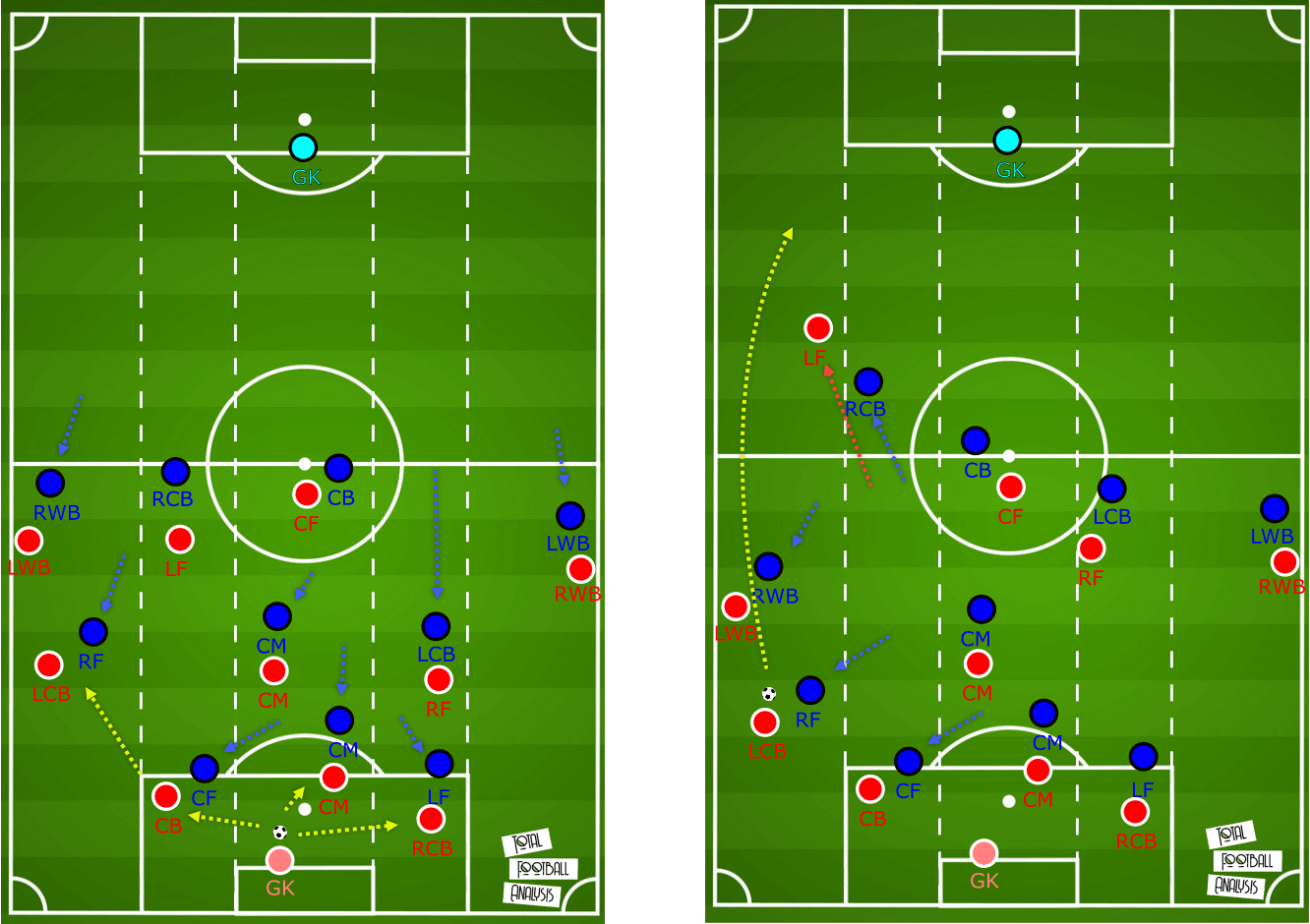
Above is a tactical illustration showing how Arsenal played long passes to meet the forward’s wide runs during the high-press. On the left, we see how Chelsea move up and tight man-for-man, as they engage the press. With sufficient space to play, Arsenal’s left-centre-back Tierney plays a long well-weighted-pass to meet the run of Aubameyang who only moves into that space from a central area moments before the ball is played.
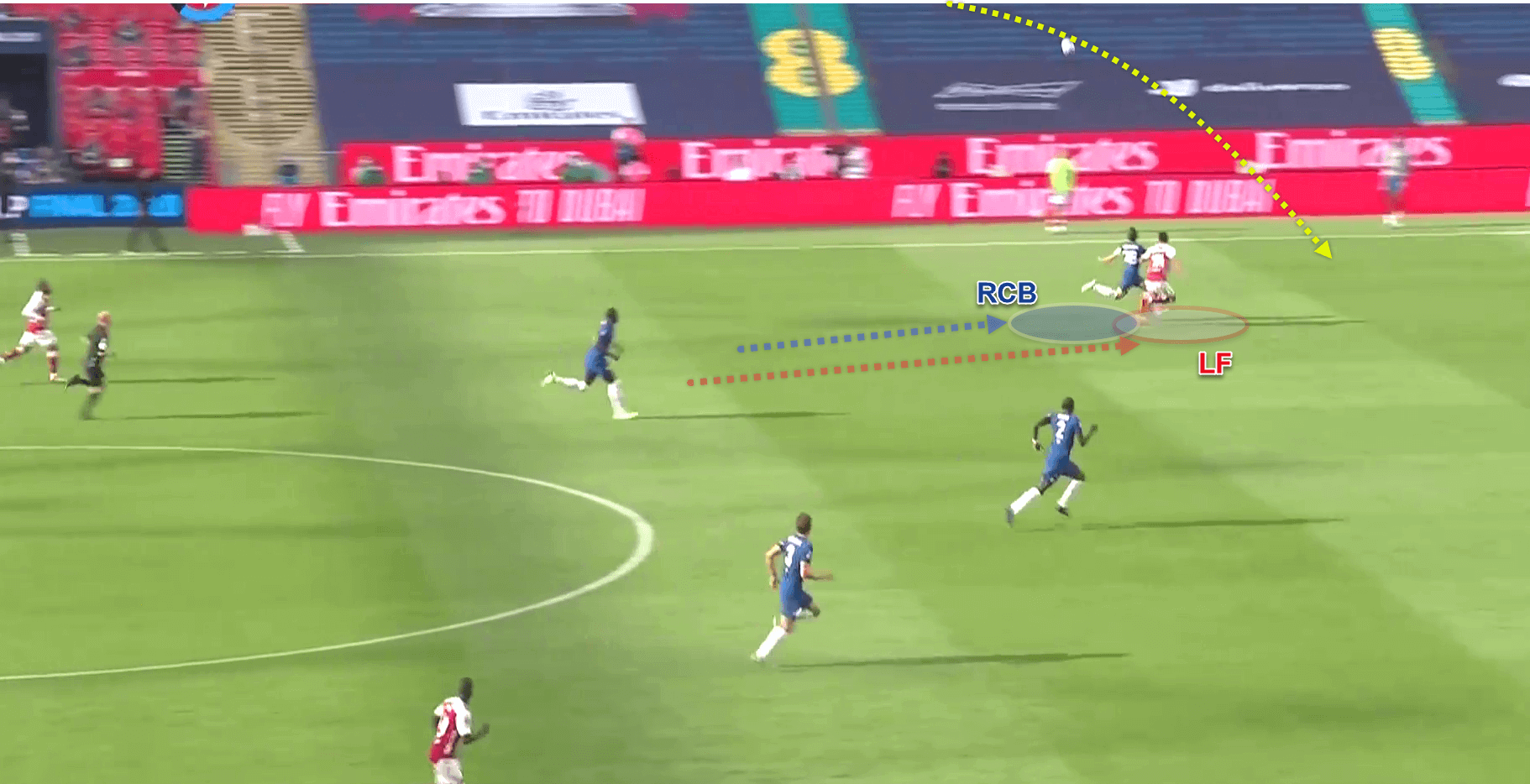
Above, we see how Aubameyang times his run to beat the offside and get in front of his defender to meet the direct ball into the opponents third. At this moment, Aubameyang draws the foul and wins his side the penalty on 26 minutes.
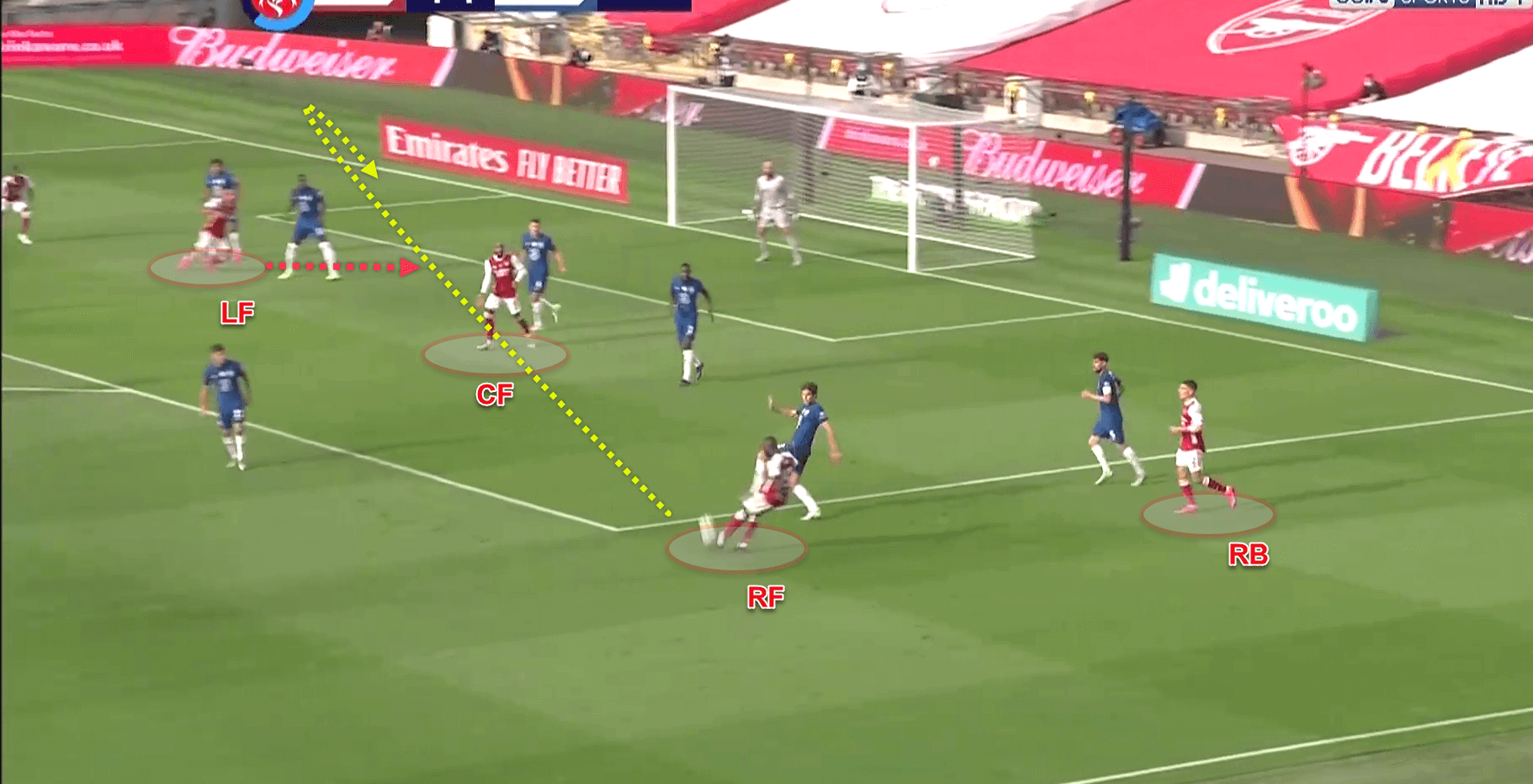
As inverted forwards, Pepe and Aubameyang offer multiple threats in front of goal as it means they can be both creator and scorer around the opponent’s box. As Arsenal formed their attacking shape in Chelsea’s third, Pepe offers and in-swinging cross to meet the back post run of Aubameyang. When either forward had sufficient space, they would drive towards the box, inviting fouls and commitment from defenders to gain an advantage cleverly.
Blue’s reactive tactics as Kovačić sees red
At 73 minutes, that is where perhaps Lampard’s biggest test as a manager was given to him, and he almost passed—going down to ten men in a cup final with 15 minutes to go. Having already made two out of his five substitutions replacing the injured Azpilicueta and Pulišić inside 50 minutes with Andreas Christensen and Pedro respectively, the Englishman had three crucial substitutions to make that would help him find the equaliser with ten men.
On 78 minutes, Giroud, Mount and Rüdiger made way for Tammy Abraham, Ross Barkley and Callum Hudson-Odoi to form a 4-4-1. Abraham would offer more in terms of pace and dribbling at defenders than Giroud while still being a threat in the air. Hudson-Odoi, like Pedro, played as an inverted winger who would drive at inside defenders as Barkley played box to box to give his side the best chance in and out of possession.
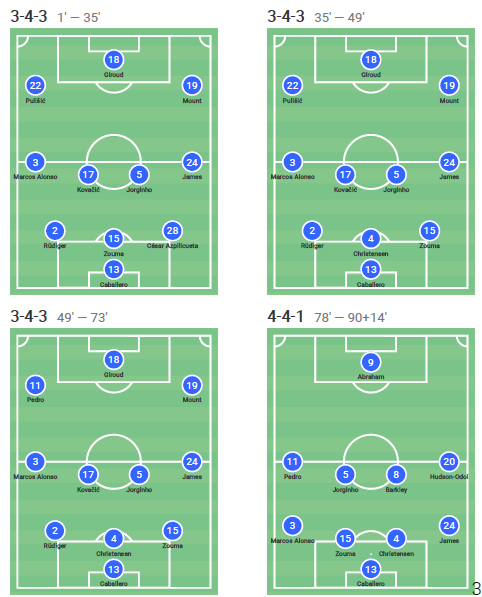
Above, we see Chelsea’s formations across 90 minutes, notice the changes made when the Blues went down to ten men (78′ – 90+14′).
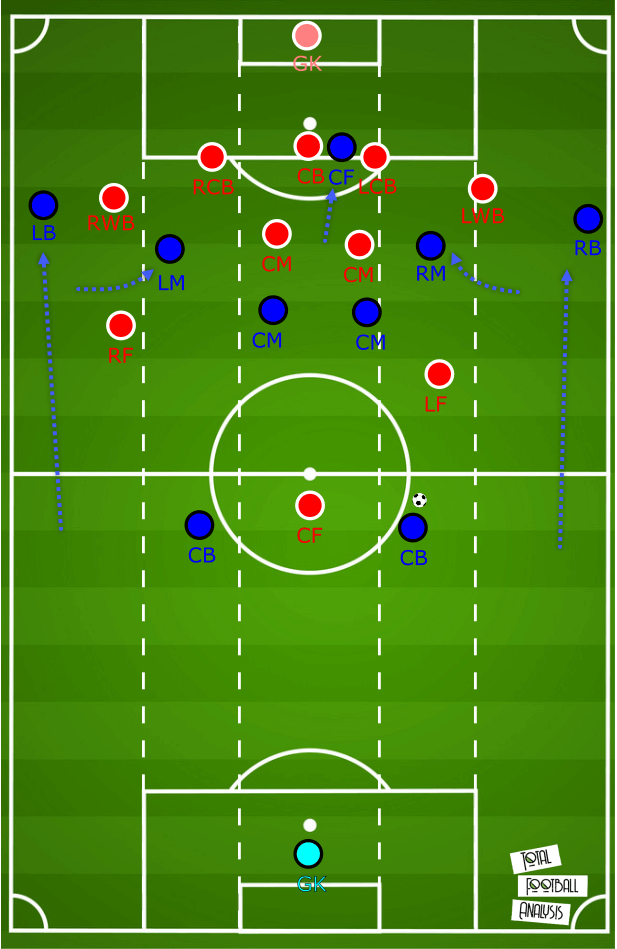
Lampard’s 4-4-1, in the attacking phase, quickly morphed into a 2-3-4 with both full-backs stretching Arsenal horizontally and serving crosses into centre-forward Abraham. By Pedro (LM) and Hudson-Odoi (RM) cutting inside, they served to create central overloads against the Gunners so as to attack the half-spaces and create space for full-backs to cross.
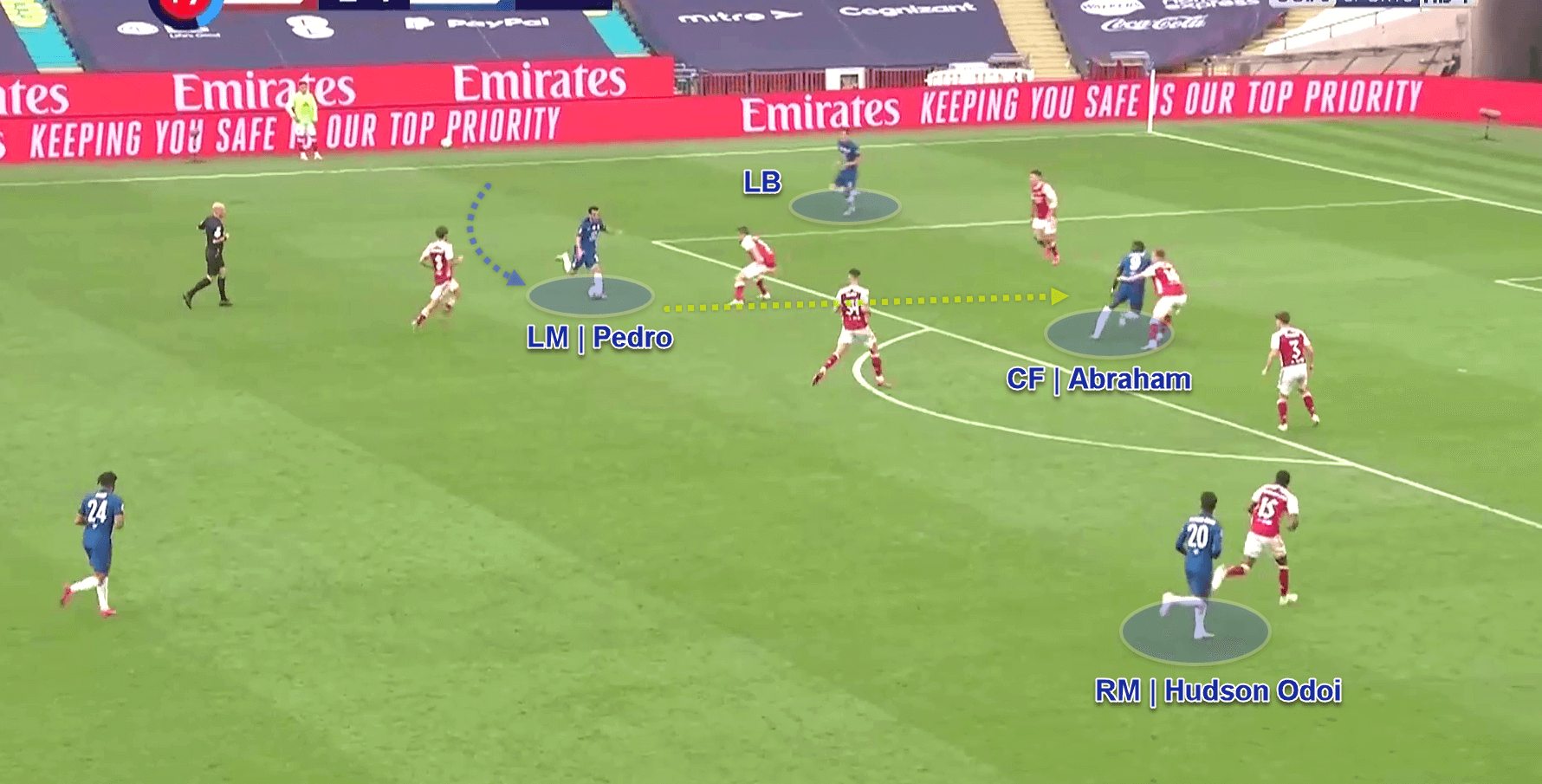
Above, we see the primary attacking position of Pedro and Hudson-Odoi. Both done well to engage the space between two Arsenal defenders, while Pedro who won 40% of his 5 attacking dribbles going towards the Arsenal box seemed the most likely of any player in blue to make the difference.
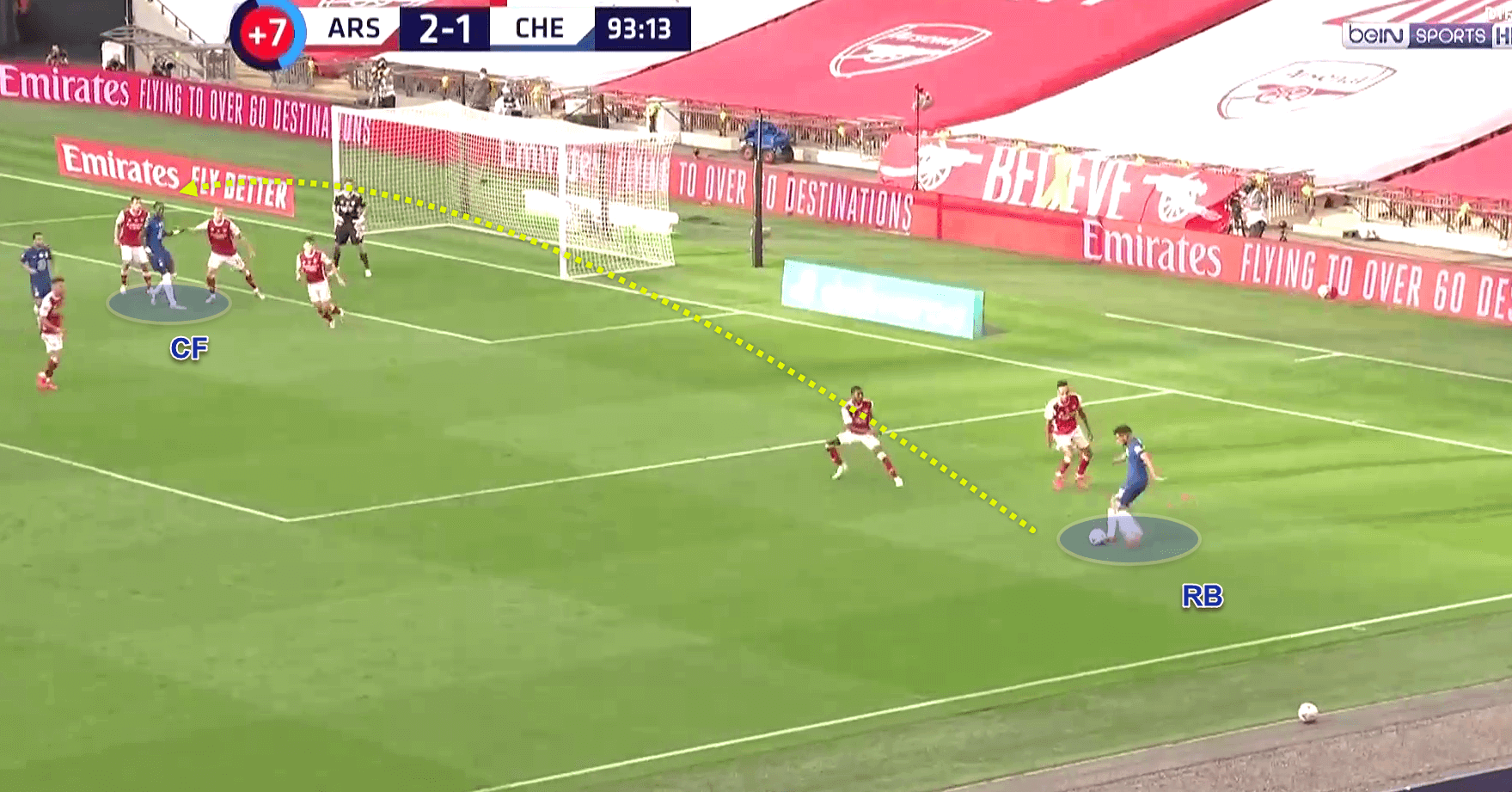
Above, we also see how Abraham was disciplined to always remain between the posts as an attacking threat to meet crosses. Right-back James finds an angle and serves a cross into the box with his less dominant foot.
Although their xG of 0.52 would not support my point, Chelsea seemed more likely to score than the Gunners in the dying embers of the game. With so much action and creative play in and around the box, the Blues had Arsenal rattled at times, showing they could create and score from multiple positions, however, all threats were nullified to the final whistle.
Credit to Arteta’s side, they showed a defensive masterclass in the second half to guarantee there would be no extra time. The Arsenal boss withdrew Lacazette on 81 minutes to put pace and the fresh legs of Eddie Nketiah on to exploit a committed Chelsea backline.
Arsenal held on, scoring the game’s only goal in the second half from a quick counter-attack on 67 minutes as Aubameyang played a world-class chip over Caballero to give Arsenal their second and game-winning goal, meaning Arsenal won 2-1.
Conclusion
Although Lampard showed humility and a strong character to speak of his side’s disappointing performance, there is a point to be made that losing Azpilicueta and Pulišić to injury so early and then losing Kovačić to a questionable red card in the last quarter of the match, it begs the question, what might have been?
The word ‘era’ seems to follow the name Mikel Arteta a lot lately, and after this magnificent accomplishment of seeing off Man City and Chelsea to lift the cup, more and more will start to believe there will be an exciting era ahead for the young Spanish manager at Arsenal.
Credit still goes to the Gunners, as they did score the two goals when it was 11 v 11, even if they may want to thank their lucky stars for having the better of some key decisions in the game. Nonetheless, the Gunners now have qualified for the Europa League as a result of this victory and subsequently denied their bitter rivals Tottenham Hotspurs a place in the Champions League.
Arsenal now can open the door of the boardroom to negotiate contracts and potential signings as their season draws to an optimistic close. Chelsea, on the other hand, makes a trip to Munich this coming week to resume their 2019/20 Champions League campaign. The Blues have a 3-0 deficit to overturn as they travel to FC Bayern München if they are to have any chance of silverware this season.
Stay tuned and continue to track the progress of Chelsea in their European campaign here on Total Football Analysis.

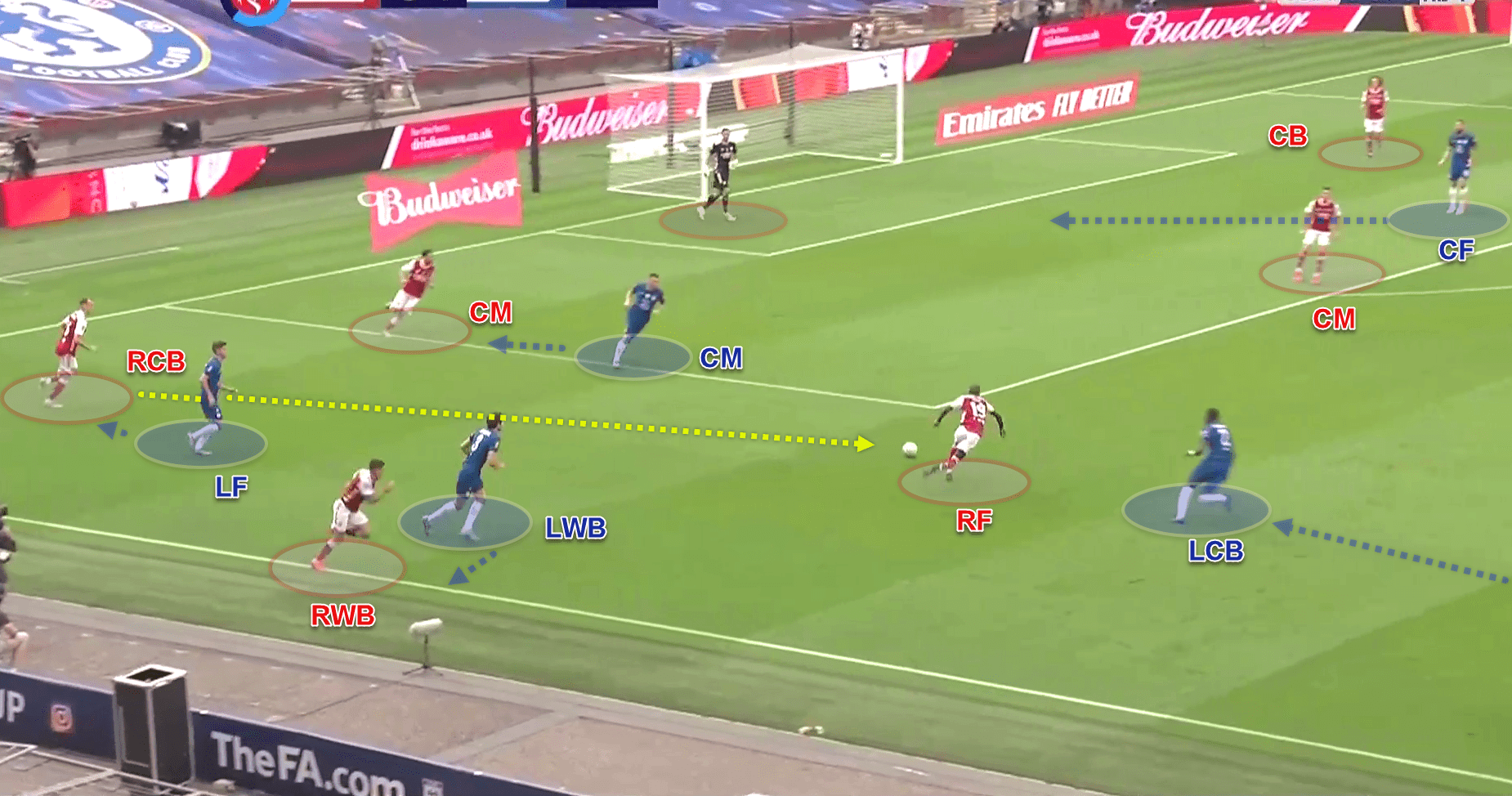


Comments